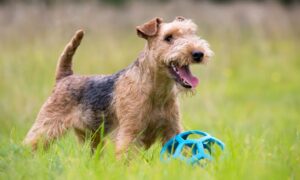Cairn Terrier
Updated May 5, 2025
Cairn Terrier
Updated May 5, 2025
Cairn Terriers may be small, but they're packed with plenty of energy and a feisty, affectionate personality. They love outdoor adventures and require consistent training, making them ideal for active households seeking a spirited dog breed.
Joyful, Inquisitive, Devoted
Male: 14 pounds
Female: 13 pounds
Male: 10 inches
Female: 9.5 inches
13 to 15 years
Black, Cream, Gray, Red, Silver, Wheaten, Brindle, Gray Brindle, Red Brindle, Cream Brindle, Black Brindle
They say you should never judge a book by its cover, and this is undeniably true for the Cairn Terrier. These adorable little pups have a rough-and-tumble appearance, but their small size often gets them mistaken for a lapdog. While they may climb into your lap for an occasional cuddle, Cairn Terriers are not content to be idle. This energetic breed thrives on activity and is happiest when they can be active with you. (The last time one was content to merely be watched was when they were on the silver screen.) And we’re not talking walks around the block, either. This diminutive dog will enjoy exploring the big, wide world as your hiking buddy. Cairn Terriers thrive on adventure, and if they could crank it up to 11, they would. So, make sure your hiking boots are ready to go, because it’s time for today’s exciting adventure.
Cairn Terrier Characteristics
Cairn Terrier Appearance
Cairn Terrier dogs may look a bit scruffy, but it’s all part of their charm. These double-coated canines sport a hard and wiry outer coat poking in all directions and, just like their souls, they’re undercoat is all soft and furry. Their lively hazel eyes are always on the hunt for their next adventure, and their black button noses are constantly sniffing the air for clues to find their next little critter. Which makes sense, of course, because one of their key characteristics is that they are hardy little explorers game for anything.

- Ears
Cairn Terriers have small, upright pointed ears set wide apart.
- Eyes
They have alert, medium-sized hazel or dark hazel eyes sunken and bordered by shaggy eyebrows.
- Nose
They have black button noses.
- Coat Length
The Cairn Terrier breed has a medium length double-coated with a hard top coat and short soft undercoat.
- Coat Color
Cairn Terriers come in a wide variety of colors, including black, cream, gray, red, silver, wheaten (variegated from light to dark) and brindle (subtle tiger stripes).
- Tail
They have a relatively short tail, full of hair but not feathery.
Cairn Terrier Temperament
There is a whole lot of personality packed into the compact Cairn Terrier. They are a friendly, sociable breed who loves making new friends wherever they go, of both the two- and four-legged variety. So, yes, you can expect to leave any trip to the dog park with a puppy playdate booked for next week. Hope you like a full social calendar! Cairns are good with kids, and their scrappy personalities allow them to enjoy the rough-and-tumble play of an afternoon outside with the little kiddos (as long as they follow the no ear or tail pulling rule).
Cairns were originally bred to hunt vermin out of rock piles, or “cairns” in Scotland, so they are a working terrier breed. Rock piles are scarce nowadays outside of Scotland, but Cairns’ high prey drive will keep them on alert for squirrels, bunnies or any other small furry animals that dare to invade their territory. Their instinct to dig is strong, so some savvy pet parents have been known to provide their Cairn Terrier with a sand box of hidden toys to dig for—this keeps their dog happy and their daisies intact. Win, win.
For the most part, their temperament is happy-go-lucky, and they’re never more content than when sharing an adventure with you. Energetic and curious, they’re always up for a game of fetch, a tussle with their favorite tug toy, or just a walk around the neighborhood. But beware the bored Cairn pup who will quickly turn into a barking Cairn pup—one who may not stop until the entertainment resumes, which just might make you your neighbor’s least favorite person. And while they are not known to be lapdogs glad to just watch the world go by, Cairn Terriers may well snuggle up at the end of a busy day for a chance to recharge before tomorrow’s adventure begins.
How to Care for a Cairn Terrier
Cairn Terrier dogs need an average amount of tending to, including regular grooming, exercise and consistent training. Fortunately, these bright little dogs are a quick study, leaving you with lots of time to play when the work is done.
Grooming
Training
Diet
Exercise
Environment
Cairn Terrier Health
Cairn Terriers’ lifespan tends to be long, about 13 to 15 years or more, and they are generally a healthy, hardy breed. But they have a few health problems you should be aware of, so you can help your pup live the longest life possible.
- Luxating Patella: This is a condition in which the kneecap moves out of its normal position when the knee joint flexes and extends. It may be treated with weight management, joint supplements, pain medication and, in severe cases, surgery.
- Diabetes Mellitus: Cairn terriers are predisposed to developing diabetes mellitus, but there is no genetic screening test available. If your pet is drinking and urinating excessively, schedule an appointment with your vet right away. Diabetes can be diagnosed with a blood test and is typically treated with insulin injections.
- Hypothyroidism: Hypothyroidism is an endocrine disease in which the body does not produce enough thyroid hormone. Symptoms include weight gain, lethargy, and hair loss. Treatment is typically daily medication.
- Cushings Disease: This is another endocrine disease where the body produces too much of the natural steroid cortisol. Blood tests are primarily used to help your vet get a diagnosis and treatment is typically daily medication.
- Globoid Cell Leukodystrophy (GCL): Also known as Krabbe disease, this genetic disorder, which damages neurological function, is sadly always fatal as there is no cure. Genetic screening tests are available so be sure to ask your breeder.
- Liver Shunts: Portosystemic vascular anomaly (PSVA) and microvascular dysplasia (MVD) are related genetic disorders that cause liver circulation to function improperly. Treatment may include medication or surgery, particularly for PSVA.
- Abnormal Kidney Development: Kidney aplasia and dysplasia are the abnormal development of one or both kidneys and are hereditary conditions. Depending on the severity, treatment may include medication, fluid therapy, kidney support supplements, special diets and more. Regular monitoring of the condition may also be called for. Genetic screening for this disorder before breeding is the only way to prevent it.
Cairn Terrier History
The origin of the Cairn Terrier lies in Scotland and the breed dates to the 17th century. They lived predominantly in the Western Highlands, in particular on the Isle of Skye, where they patrolled game preserves and farms.
For many years, they were lumped together with other terriers and collectively called “Scotch Terriers.” It wasn’t until the late 1800s that they were recognized as their own distinct breed. In those days, large mounds of rocks, or “cairns,” were used to mark a boundary or grave. Rodents and other vermin would take up residence inside and underneath the cairns and it was the Cairn Terrier’s job to dig and evict the critters. This was usually a one-dog job, but sometimes multiple dogs would work together as a pack and go after bigger critters such as foxes and otters.
The Cairn’s bravery, tenacity and independence were qualities that served them well when they were working the windswept Highlands of Scotland. The American Kennel Club (AKC) recognized the Cairn Terrier in 1913 as the 69th breed. In 1939, the whole world met the adorable breed when a Cairn Terrier was picked to play Toto in a little movie called “The Wizard of Oz.”
You can find a Cairn Terrier puppy to adopt today by checking out a list of reputable breeders on the American Kennel Club’s website. Depending on the breeder, costs may vary, but a price you can expect to pay for a Cairn Terrier is between $1,000-$2,000. If you’re interested in a rescue dog, the Cairn Terrier Club of America also includes contact information for rescues that may be useful or you can keep an eye out for the breed at your local shelter. Search Chewy’s database of adoptable dogs for Cairn Terriers in your area.
FAQs
How do you pronounce Cairn Terrier?
Do Cairn Terriers shed?
How long do Cairn Terriers live?
How big do Cairn Terriers get?
What are the most common Cairn Terrier mixes?
Expert input provided by veterinarian Susan Hankerd DVM, owner of the Auburn Animal Hospital in Rochester, Mich., and certified dog trainer Bonny Wainz, IACP-CDT, CDTA, PDTI, owner of Alternative Canine Training in Royal Oak, Mich.
Breed characteristic ratings provided by veterinarian Dr. Sarah J. Wooten, DVM, CVJ, a veterinarian at Sheep Draw Veterinary Hospital in Greeley, Colorado; dog trainer and behavior consultant Irith Bloom, CPDT-KSA, CBCC-KA, CDBC, owner of The Sophisticated Dog, LLC, in Los Angeles; and certified animal behavior consultant Amy Shojai, CABC, in Sherman, Texas.
The health content was medically reviewed by Chewy vets.








